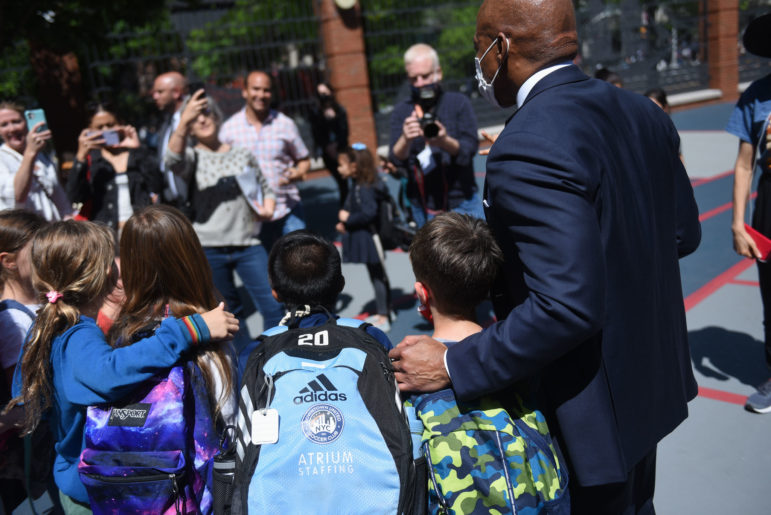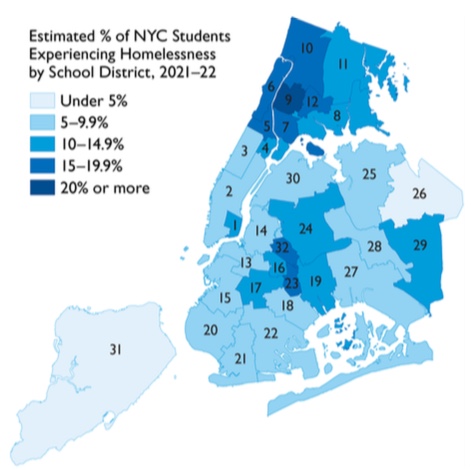Though total enrollment in city schools fell by 3.2 percent, the number of homeless-identifying students increased by 3.3 percent. Those 104,000 students include 29,000 who spent time in shelters, 69,000 temporarily sharing housing with others, and approximately 5,500 who were unsheltered—living in cars, parks, or abandoned buildings.

Michael Appleton/Mayoral Photography Office
Mayor Eric Adams visits a school in Manhattan in May 2022.
For the seventh year in a row and through two mayoral administrations, more than 100,000 New York City students experienced homelessness in the most recent full school year, increasing by approximately 3,000 students compared to the year before, data released this week shows.
For the 2021-2022 school year, approximately 10 percent of students, “enough children to fill Yankee Stadium twice over” lacked a permanent home, according to the data analysis by Advocates for Children of New York’s (AFC).
READ MORE: NYC’s Schools Funding Formula Should Consider Homeless Students, Advocates Say
Though total enrollment in city schools fell by 3.2 percent, the number of homeless-identifying students increased by 3.3 percent. Those 104,000 students include 29,000 who spent time in shelters, 69,000 temporarily sharing housing with others, and approximately 5,500 who were unsheltered—living in cars, parks, or abandoned buildings.

Geographically, the highest rates of student homelessness were in the southwest Bronx, with a one-in-every-five student ratio, while the lowest was Staten Island, where one in 28 children were homeless. The number of homeless students in Queens increased by 12.3 percent.
That total number has increased over the past few months with the influx of migrant families with school-aged children arriving in New York City and seeking asylum. At least 5,500 new students living in shelter enrolled in classes this fall, according to the news site Chalkbeat. The DOE must ensure their needs are being met, “while not losing sight of the longstanding issues facing the tens of thousands of students who were already homeless,” Jennifer Pringle, the director of AFC’s Learners in Temporary Housing Project, said in a statement.
Many more students may lose their housing before the end of the current school year in June, says the advocacy group VOCAL-NY, considering that hundreds of thousands of eviction cases are transitioning through housing court.
“If these 100,000 children made up their own school district, it would be a district larger than 99.5% of all other districts nationwide,” executive director of AFC Kim Sweet said in a statement.
Housing insecure families must navigate myriad obstacles when it comes to education. Letasha Betancourt, a leader with VOCAL-NY’s Homelessness Union, explained that while she was sheltered with two children who had special needs, and they had to commute from their shelter in Brooklyn to Staten Island—but were still penalized if they were late. We need our state and city to do better,” Betancourt said in press release.
In the 2020-2021 school year, students in shelters dropped out of high school more than three times the rate of others, and homeless students in previous years were more likely to miss school than their permanently-housed peers. While there is a need to rectify this issue at its root, there also has to be intentions to get these students to class and have them receive the support necessary to excel, Sweet explained.
AFC and other advocates have called for the city to hire 100 shelter-based DOE community Coordinators to guide families through the educational system and resolve issues that are sure to come up along the way. The DOE should also boost staffing levels at its Office of Students in Temporary Housing, advocates say.
The uptick in homeless students comes as the city considers changes to its Fair Student Funding Formula, used to distribute most of the education budget to the majority of its public schools. Advocates want to revise the formula to offer additional funds to schools with homeless students to better meet their needs.








